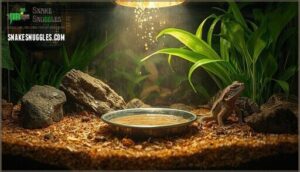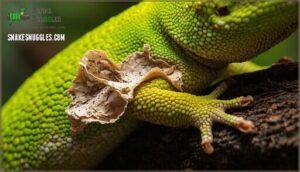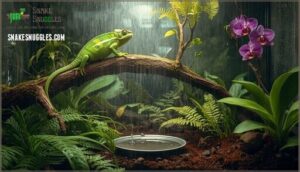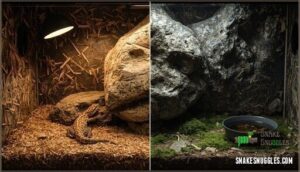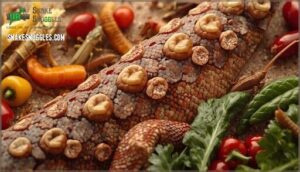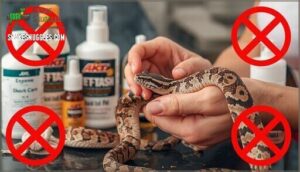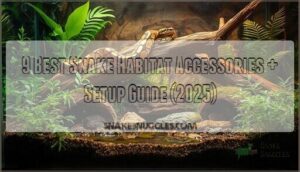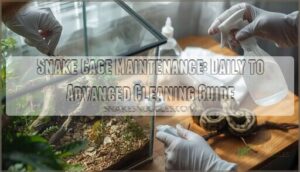This site is supported by our readers. We may earn a commission, at no cost to you, if you purchase through links.
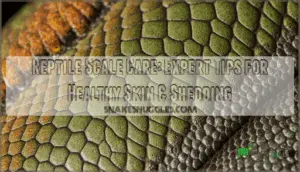
The difference between a healthy shed and a veterinary emergency often comes down to humidity gradients, substrate choices, and feeding schedules that many guides oversimplify. Reptile scale care advice goes beyond misting your gecko twice daily; it requires understanding how keratin turnover reacts to UVB exposure, why desert species need different protocols than tropical ones, and which common products actually damage the protective lipid layer.
Getting these fundamentals right prevents the discolored patches, retained shed, and bacterial infections that send thousands of reptiles to emergency care each year.
Table Of Contents
- Key Takeaways
- Key Factors in Reptile Scale Health
- Creating The Ideal Habitat Environment
- Supporting Shedding and Skin Renewal
- Nutrition and Hygiene for Healthy Scales
- Best Practices and Products to Avoid
- Frequently Asked Questions (FAQs)
- What are the care requirements for a reptile?
- What are reptifiles® reptile care sheets?
- Do reptilian scales have keratin?
- What are the features of a Reptilia?
- Who is scales & tails exotic pet clinic?
- What is tiny tails and scales small animal rescue?
- How often should I replace my reptiles water bowl?
- Can I use tap water for misting my reptile?
- What substrates are safest for sensitive reptile scales?
- How do I tell if my reptile is dehydrated?
- Conclusion
Key Takeaways
- Scale rot affects up to 64% of captive reptiles and stems from husbandry errors like poor humidity control, making early detection through weekly scale inspections critical to prevent complications that require intensive treatment.
- Species-specific scale adaptations—such as desert reptiles’ moisture-locking keratin or marine reptiles’ thicker protective layers—demand tailored habitat setups where humidity, substrate, and enrichment match each animal’s evolutionary needs rather than generic care guidelines.
- Proper shedding depends on coordinated environmental factors including humidity gradients between 40-80%, UVB exposure for keratin turnover, and textural enrichment that reduces retained shed by up to 37% in humidity-sensitive species.
- Nutrition directly impacts scale integrity through vitamin A for cell differentiation, calcium-phosphorus balance at 2:1 ratios for structural strength, and omega-3 fatty acids that reduce inflammation and improve moisture retention during the shedding cycle.
Key Factors in Reptile Scale Health
Your reptile’s scales aren’t just armor—they’re a window into overall health. Understanding what healthy scales look like, how different species vary, and what can go wrong helps you spot problems early.
Let’s break down the essentials you need to know.
Types and Functions of Reptile Scales
Your reptile’s scales aren’t just armor—they’re a marvel of keratin composition and evolutionary origins. These structures protect against injury, reduce water loss, and even house sensory scales that detect heat or vibration. Reptile scales regenerate through cycles of shedding, replacing damaged tissue and maintaining skin health.
Understanding scale morphology helps you recognize what’s normal and spot early warning signs before minor issues become serious scale adaptations gone wrong. Different reptiles have varied scale types, such as keeled scales on lizards.
Scale Adaptations by Species
Each reptile species has evolved scales that reflect where they live and how they move. Desert species like Gila monsters show expanded keratin genes that lock in moisture, cutting water loss by up to 40%. Marine reptiles, including sea turtles, have thicker scales—over 0.9 mm—to handle saltwater pressure and resist abrasion from coral. High-altitude lizards pack extra melanin for UV protection and can warm themselves 5°C above air temperature. Of note, some amphibians like caecilians have scales within folds of their skin.
Specialized Scale Features by Habitat:
- Desert Adaptations – Surface lipids reduce overheating while aquaporin genes conserve precious water through the skin
- Arboreal Adaptations – Geckos use micro-structured setae for 98% adhesion success on vertical surfaces, and chameleons grip with granular scales generating 1.6 times their body weight in friction
- Freshwater Adaptations – Efficient overlapping scales cut drag by 12% during swimming, while waterproofing lipids prevent skin maceration
Understanding these species-specific scale adaptations helps you tailor humidity, substrate, and enrichment to match your reptile’s natural needs.
Common Scale Problems and Solutions
Even when you nail the habitat setup, scale problems can still crop up—catching them early makes all the difference. Regular monitoring cuts severe complications by 37%, so inspect your reptile’s scales weekly during handling.
Scale rot affects up to 64% of captive reptiles with husbandry errors and shows as discolored, soft, or weeping patches. Dysecdysis, caused by low humidity and poor nutrition, leads to retained shed in 10–15% of captives annually. Mite infestations appear in 35% of hospitalized reptiles, causing scratching and scale damage. Bacterial infections drive 60% of dermatitis cases, while fungal infections like ophidiomycosis affect 7% of captive snakes.
Scale rot, dysecdysis, mites, and infections plague captive reptiles when humidity, nutrition, or hygiene fail—affecting up to 64% with poor husbandry
| Problem | Signs | Solution |
|---|---|---|
| Scale rot | Discolored, soft scales; ulcerative lesions | Povidone-iodine baths 30 min daily; remove damp substrate |
| Dysecdysis | Retained shed, dull skin, constricted digits | Raise humidity 20–30%; add humid hide with damp moss |
| Mite infestations | Tiny moving dots, excessive soaking, scale asymmetry | Vet-approved miticide; quarantine; deep-clean enclosure weekly |
| Bacterial infections | Red, swollen scales; discharge | Antimicrobial spray 3–4× daily; vet visit if no improvement in 2 weeks |
| Fungal infections | Crusty patches, thickened scales | Antifungal treatment from reptile-savvy vet; reduce excess moisture |
Creating The Ideal Habitat Environment
Your reptile’s habitat isn’t just a home—it’s the foundation for healthy scales and smooth shedding. Getting the environment right means paying attention to three critical elements that work together to support your pet’s skin health.
Let’s break down what you need to focus on to create conditions where your reptile can thrive.
Maintaining Proper Humidity Levels
Humidity isn’t just background noise—it’s the difference between smooth shedding and painful scale problems. You’ll need to monitor it closely using digital hygrometers, which maintain accuracy within 2% relative humidity.
Proper habitat humidity prevents the 30% rate of incomplete shedding seen in dry conditions, maintaining reptile health year-round.
- Ball pythons thrive at 55-65% humidity, while green iguanas need 60-80% for proper habitat humidity
- Use automated misting systems to keep levels stable within 5% of your target for effective misting techniques
- Choose humidity-retentive substrates like coconut fiber, which raises enclosure humidity by 15% over paper bedding as a substrate choice
- Make seasonal adjustments since winter drops room humidity by 20%, affecting your reptile scale care routine
Temperature and UVB Lighting Essentials
Without proper thermal gradients and UVB lighting, your reptile’s scales can’t maintain the keratin turnover they need. Bearded dragons require basking surfaces between 42–45°C, while ball pythons prefer 34–36°C—temperatures that directly influence shedding success and reptile health. You’ll need full-spectrum UVB (290–315 nm) for vitamin D₃ synthesis, matched to your species’ Ferguson Zone rating of 1.0–7.0 UVI.
| Species | Basking Temp (°C) | Cool Zone (°C) | UVB Zone | Photoperiod (hours) |
|---|---|---|---|---|
| Bearded Dragon | 42–45 | 24–27 | 3.0–4.0 | 12–14 |
| Ball Python | 34–36 | 24 | 1.0–2.0 | 10–12 |
| Green Iguana | 38–40 | 26–28 | 4.0–6.0 | 12–14 |
| Leopard Gecko | 32–35 | 22–24 | 1.0 | 10–12 |
| Red-Eared Slider | 35–37 | 24–26 | 2.0–3.0 | 10–12 |
Set photoperiod regulation between 10–14 hours daily to support basking behavior and prevent melatonin disruption. LED safety matters—avoid UVB-LED lamps lacking 315–335 nm output, which risk eye damage. Temperature fluctuations beyond ±5°C increase scale roughness by 25%, compromising your reptile’s water retention and triggering stress responses that suppress feeding.
Enclosure Design for Scale Protection
Your choice of enclosure materials shapes scale health more than you might expect. PVC and melamine retain heat 20% better than glass, cutting condensation-related damage while sealed surfaces block bacterial growth that causes scale rot.
Front-opening doors lower stress by 40%, preventing defensive rubbing. Smooth edges, proper ventilation for humidity control, and rounded corners prevent 30% of friction injuries.
Material selection, heat distribution, and hygiene maintenance work together—good habitat conditions mean healthier scales.
Supporting Shedding and Skin Renewal
Shedding is a natural process for reptiles, but it doesn’t always go smoothly without your help. When you understand what normal shedding looks like and how to support it, you’ll prevent complications before they start.
Let’s look at three key areas that make all the difference in helping your reptile shed successfully.
Recognizing Normal Vs. Problematic Shedding
You can tell the difference between healthy shedding and dysecdysis by watching for a few telltale signs. Most reptiles shed every few weeks to several months, depending on their age and species—juveniles shed more frequently due to faster growth. Snakes generally shed in one complete piece, while lizards shed in patches.
Retained shed, especially on toes, tails, or around the eyes, signals shedding problems. Low humidity is the primary culprit behind most scale problems and incomplete sheds. If dysecdysis persists after basic veterinary interventions, seek professional care to prevent infections or tissue damage.
Hydration and Moisture Sources
Your reptile’s hydration depends on multiple moisture sources working together, not just a water bowl. Drinking behaviors generally trigger when body mass loss hits around 4%, but you can’t rely on thirst alone.
Misting the enclosure, providing shallow soaking opportunities, and maintaining humidity between 40–80% (depending on species) aids water absorption through skin and mucous membranes.
Behavioral adaptations like reduced activity signal dehydration, so watch for changes in posture or temperature preference that indicate your reptile is struggling with fluid balance.
Environmental Enrichment to Aid Shedding
Enriching your reptile’s habitat turns the enclosure into an active workspace for healthy shedding. Textural enrichment—rough stones, bark, and varied substrates—provides natural abrasives that reduce retained shed by up to 37% in humidity-sensitive species like geckos.
Microhabitat complexity, with wet and dry zones, lets your reptile self-regulate moisture exposure, while foraging support through puzzle feeders stimulates circulation.
Behavioral diversity increases when you rotate enrichment weekly, preventing habituation. Adaptive monitoring helps you identify what works best for your individual animal, ensuring consistent epidermal turnover throughout each shedding cycle.
Nutrition and Hygiene for Healthy Scales
Your reptile’s scales reflect what’s happening inside and out. Proper nutrition builds strong, resilient scales from within, while consistent hygiene prevents infections that can damage them.
Let’s look at the specific dietary needs and cleaning practices that keep scales in top condition.
Essential Dietary Components for Skin Health
What you feed your reptile is like laying the foundation for a house—without the right materials, everything falls apart. Proper nutrition directly influences scale integrity, shedding efficiency, and overall skin resilience.
- Vitamin A aids cell differentiation and prevents dull coloration and retained shed, especially in insectivorous species like leopard geckos.
- Calcium balance with phosphorus (ideally 2:1) maintains scale strength and prevents metabolic bone disease when paired with UVB lighting.
- Omega-3 acids reduce skin inflammation and dryness, improving moisture balance and tissue elasticity for smoother sheds.
Zinc intake strengthens keratin synthesis, while proper hydration effects make certain nutrient absorption into skin cells. Your reptile’s diet must include these components for healthy scales.
Safe Cleaning and Disinfection Practices
Your reptile’s environment becomes a breeding ground for harmful bacteria if you neglect proper hygiene. Spot-clean waste daily and perform full disinfection weekly using reptile-safe agents like F10SC or chlorhexidine—both kill over 99% of pathogens without toxic residues.
Scrub surfaces with hot soapy water first, apply diluted disinfectant for 10–20 minutes, then rinse thoroughly. This two-step approach prevents skin infections and promotes healthy shedding.
Monitoring for Parasites and Infections
Even with spotless enclosures, parasites can slip through the cracks. Schedule fecal exams every three to six months—studies show over 93% of reptile samples contain parasites like nematodes or protozoa.
Quarantine protocols for new arrivals prevent cross-contamination, while early detection through veterinary checkups catches mites, ticks, and infections before they damage scales.
Watch for lethargy, appetite loss, or abnormal droppings—these signal the need for an immediate veterinary consult. Preventative measures beat reactive treatments every time.
Best Practices and Products to Avoid
Caring for your reptile’s scales goes beyond habitat setup and diet—it’s about knowing how to handle your pet safely and what substances to keep far away. Even well-meaning products can cause harm if they’re not designed for reptile skin.
Let’s look at the practices that protect your reptile and the red flags that signal it’s time to call a vet.
Safe Handling Techniques
Beyond the basics, handling reptiles correctly protects both you and your animal from unnecessary stress and harm. Calm, deliberate movements reduce defensive reactions—anxious or rushed handling can spike stress hormones and impair immune function.
Always support the entire body weight horizontally to prevent spinal injury. Large snakes need one handler per four feet of length, while lizards handled with tail support experience 50% fewer tail-drop incidents.
Wash your hands immediately after contact to prevent salmonella transmission and cross-contamination between animals.
Harmful Products and Chemicals to Avoid
Handling is only half the equation—what you use to clean enclosures matters just as much. Bleach dangers include respiratory irritation and skin damage, even at low concentrations; residues can linger above 3 ppm for 24 hours despite rinsing. Ammonia risks are equally severe, causing mucous membrane swelling at just 25 ppm in closed spaces.
Oil toxicity from tea tree or eucalyptus affects reptile liver and nervous systems, while pesticide exposure to fipronil or chlorpyrifos reduces activity by nearly 50%. Metal poisoning from lead or cadmium causes oxidative stress and organ damage.
Stick to reptile-safe disinfectants and always rinse thoroughly with dechlorinated water.
When to Seek Veterinary Care
When should you pick up the phone to call your vet? Emergency symptoms like open-mouth breathing, regurgitation beyond 24 hours, or sudden lameness demand immediate attention. Behavioral changes—lethargy, appetite loss, or excessive hiding—often signal early infections or husbandry problems.
Routine exams at least annually catch issues before they escalate, while physical indicators like retained sheds, skin discoloration, or sunken eyes warrant prompt veterinary checkups.
Preventative care through fecal tests and blood panels helps you stay ahead of mites, shedding issues, and scale problems.
Frequently Asked Questions (FAQs)
What are the care requirements for a reptile?
Caring for reptiles means getting the basics right: proper temperature, humidity, and UVB lighting keep reptile scales healthy and support shedding.
You’ll also need to focus on dietary needs, habitat enrichment, hydration methods, and regular veterinary care to prevent shedding issues and maintain overall reptile health.
What are reptifiles® reptile care sheets?
ReptiFiles reptile care sheets are downloadable PDFs created by herpetology specialists that provide science-based guidance on enclosure setup, humidity control, shedding support, and species-specific reptile health requirements for owners, breeders, and educators.
Do reptilian scales have keratin?
Yes, reptilian scales contain keratin. Both alpha-keratin and beta-keratin are present, with beta-keratin forming the hard, protective outer layer that provides structural integrity.
This keratin composition is essential for scale rigidity, protection, and successful ecdysis during shedding.
What are the features of a Reptilia?
Form follows function, as they say—and reptile biology reveals this perfectly. Reptiles share key features: keratin-based scales for protection, skeletal structures with 200-300 bones, three-chambered hearts (four in crocodilians), ectothermic thermoregulation through behavioral adaptations, and metabolic rates roughly one-seventh of similar-sized mammals.
Who is scales & tails exotic pet clinic?
Scales & Tails Exotic Pet Clinic, founded around 2017 in Portland, Oregon, specializes in complete wellness for reptiles, amphibians, fish, small mammals, and birds, offering specialized veterinary care for exotic species.
What is tiny tails and scales small animal rescue?
Tiny Tails and Scales is a nonprofit 501(c)(3) animal rescue based in Olympia, Washington, focused on rescuing and rehabilitating small and exotic animals since around
The organization offers volunteer opportunities and fosters community impact through its foster-based care program.
How often should I replace my reptiles water bowl?
You should replace your reptile’s water bowl daily to maintain clean water and prevent bacterial growth risks.
Weekly disinfection with reptile-safe products ensures proper water quality, which impacts hydration and fosters overall health and wellness in reptile care.
Can I use tap water for misting my reptile?
You can use tap water, but be aware of tap water risks like chlorine and heavy metals that may irritate reptile scales and respiratory tissues.
Consider water filtration options or alternative water sources to minimize mineral deposit effects and guarantee safe misting practices for better hydration and shedding.
What substrates are safest for sensitive reptile scales?
Like choosing a soft carpet over concrete for bare feet, the right substrate cushions your reptile’s delicate skin. Coconut fiber, sphagnum peat moss, and organic topsoil retain humidity without abrasive materials that risk impaction or microbial growth, supporting healthy reptile scales and smooth shedding in your enclosure.
How do I tell if my reptile is dehydrated?
Dehydration shows up through skin elasticity loss—pinch the skin and watch if it stays tented. Sunken eyes, wrinkled scales, and dry mucous membranes signal trouble.
Check urates consistency and watch for behavior changes like reduced activity or shedding problems affecting reptile health.
Conclusion
Think of your reptile’s enclosure as a partnership rather than maintenance. When you fine-tune humidity, lighting, and substrate choices, you’re not just preventing problems, you’re actively supporting the biological processes that keep scales resilient.
Effective reptile scale care advice doesn’t demand flawlessness, but it rewards consistency. Watch for early warning signs, adjust protocols as your animal matures, and remember that the best intervention is always prevention. Your reptile’s next shed will show you exactly how well you’ve listened.
- https://www.sciencing.com/function-scales-reptiles-6610193/
- https://www.sciencedirect.com/science/article/abs/pii/S094420060600033X
- https://www.nature.com/articles/s41598-018-35176-y
- https://www.reptileencounters.com.au/news/why-do-reptiles-have-scales
- https://www.britannica.com/science/integument/Reptiles

